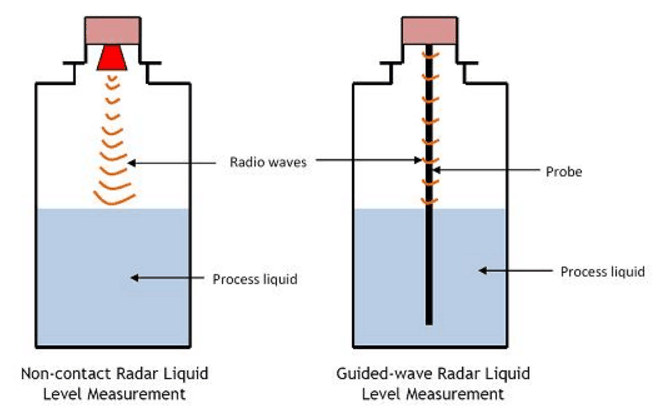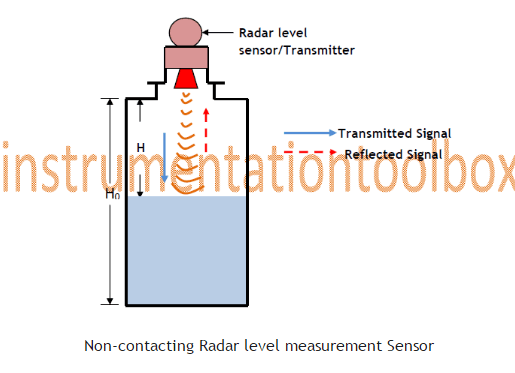Radar level instruments measure the distance from the transmitter/sensor (located at some high point)to the surface of a process material located further below in much the same way as ultrasonic level sensor, by measuring the time-of -flight of a traveling wave and then determine the level of the process material. They are regarded as continuous level measurement devices because they continue to measure level even as the level of the liquid in the vessel changes.
The fundamental difference between a radar level instrument and an ultrasonic level instruments is the type of wave used. Radar level instruments use radio waves instead of sound waves used in ultrasonic instruments. Radio waves are electromagnetic in nature (comprised of alternating electric and magnetic fields), with very high frequency in the microwave frequency range - GHz.
There are two basic types of level radar instruments: guided-wave radar and non-contact wave radar. Guided-wave radar instruments use wave guide "probes" to guide the radio waves into the process liquid while non-contact radar instruments send radio waves out through open space to reflect off process material. Note that guide-wave radar instruments are used in applications where the dielectric of the process liquid is quiet low. All radar level instruments use an antenna to broadcast or send radio signals to the process liquid whose level is to be determined. The diagram below illustrates these two approaches:

To measure the level of a liquid or solid in this type of radar instrument, radar signals are transmitted from the antenna of a radar instrument located at the top of the tank or vessel as shown below:
Non-contact level measurement using radar has two main modulation techniques: pulse radar and FMCW(Frequency Modulate Continuous Wave) radar techniques.

In the pulse radar technique, pulse radar sent out a microwave signal that bounces off the product surface and returns to the gauge. The transmitter measures the time delay between the transmitted and received echo signal and on-board microprocessor calculates the distance to the liquid surface using the formula:
Distance = [Speed of Light*Time Delay]/2
To calculate liquid level, the transmitter is programmed with the reference gauge height of the application (as show above)-usually the bottom of the tank or chamber. The liquid level is then calculated by the microprocessor in the transmitter.
In the FMCW radar technique, microwaves are transmitted towards the product surface, but the transmitted signal is of continuously varying frequency. When the signal has travelled down to the liquid surface and back to the antenna, it is mixed with the signal that is being transmitted at the same time. The difference in frequency between the received and transmitted signal is directly proportional to the distance to the liquid with high precision.
The frequency of non-contacting radar sensors can impact its performance. A lower frequency reduces sensitivity to vapor, foam and contamination of the antenna, whereas a higher frequency keeps the radar beam narrow in order to minimize influence from nozzles, walls and disturbing objects. Beam width is inversely proportional to antenna size. The beam width of a given frequency will decrease as the antenna size increase.
Non-contact radar sensor can be used in application from 1m to 70m.
Accuracy Level of Radar Instruments
The achievable accuracy of any radar level measurement system depends heavily on the type of application, the antenna design, mechanical installation, the state and quality of the electronics and echo processing software employed. Even though the effects of temperature and pressure variations are very small, compensation methods are still being used for these parameters. Other influences on accuracy of radar level instrument include to noise radio and interference.
Areas of Application
Radar level instruments are widely used to measure the level of liquid, slurries as well as many solids in storage tank refineries and tank terminal. These instruments operate in a wide range of temperature, pressure, vapor das mixtures and various process conditions.
Application Limitations
Solid
Radar level instruments are quite specific in their application of use. Radar level instrument should be avoided as much of possible on the solids due to the weak signal reflection that occurs.
Low Dielectric Process Fluids
Non-contact radar sensors perform poorly with low dielectric process fluids. With low dielectric process fluid, much of the radiated energy is lost to the fluid, leaving very little energy to be reflected back to the gauge. Water and most chemical solution have a high dielectric constant; fuel oil, lube oil and some solids, such as lime, have a low dielectric constant. Their application is not suitable for these kinds of low dielectric fluids.
Surface Turbulence
If the surface is turbulent, whether from agitation, product blending, or splashing, more of the signal is lost. A combination of a low dielectric fluid and turbulence can limit the return signal to a non-contact radar sensor. To solve the problem of turbulence, bypass pipes or stilling wells can be used to isolate the surface from the turbulence.
Advantages
Used on difficult 'hard-to-handle' applications
High accuracy
Non-contact
Can measure level through plastic tanks
Used to monitor contents of boxes or other multi-media material
Detect obstructions in chutes or presses
Disadvantages
Very sensitive to build-up on sensor surface
They are very expensive. Price increases with increasing accuracy.
If you are interested, please feel free to contact us!
